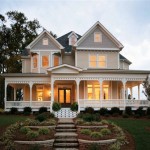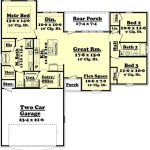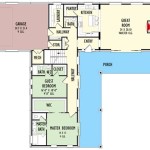House Plans: One Story with Porches
One-story house plans with porches represent a popular design choice for a variety of reasons. The appeal stems from their accessibility, ease of maintenance, and the inherent charm associated with single-level living. The addition of a porch enhances the livability of the home, blurring the lines between indoor and outdoor spaces and fostering a sense of connection with the surrounding environment. These types of house plans cater to a broad demographic, including families with young children, aging individuals seeking accessibility, and those who simply appreciate the convenience and aesthetic of a ranch-style home.
The architectural style of a one-story house with a porch can vary significantly. Common styles include Craftsman, Ranch, Farmhouse, and Contemporary. Each style possesses distinct characteristics in terms of materials, rooflines, and detailing. The choice of style depends largely on personal preference and the overall aesthetic of the neighborhood.
The layout of the interior is another crucial aspect. Open floor plans are frequently incorporated into one-story designs, promoting a sense of spaciousness and facilitating interaction between family members. Considerations for bedrooms, bathrooms, kitchen design, and living areas need to be carefully addressed to ensure the functionality and comfort of the home.
Accessibility and Aging in Place
One of the primary advantages of a one-story house plan is its inherent accessibility. The absence of stairs eliminates a significant barrier for individuals with mobility limitations, including those using wheelchairs or walkers. This makes one-story homes an ideal choice for aging in place, allowing homeowners to remain in their homes comfortably and safely as they grow older. Porches further enhance accessibility by providing a level transition from the outdoors to the indoors. Ramps can be easily integrated into porch designs to accommodate wheelchairs or scooters.
Features that support accessibility within the home include wider doorways, roll-in showers, grab bars in bathrooms, and adjustable countertops. These features can be seamlessly integrated into a one-story house plan, providing a comfortable and functional living environment for individuals with diverse needs. The focus on accessibility not only benefits those with mobility challenges but also enhances the overall convenience and usability of the home for all residents.
The design of the porch itself should prioritize accessibility. Smooth, non-slip surfaces are essential to prevent falls. Adequate lighting is also crucial, particularly during the evening hours. The porch railing should be designed to provide support and stability while also meeting building code requirements. These considerations ensure that the porch is a safe and enjoyable space for everyone.
Enhancing Outdoor Living with Porches
Porches extend the usable living space of a home by providing an outdoor area for relaxation, entertaining, and enjoying the surrounding environment. A well-designed porch can significantly enhance the quality of life for homeowners, providing a space to unwind after a long day, host gatherings with friends and family, or simply enjoy the fresh air. The size and design of the porch can be customized to suit individual needs and preferences.
Different types of porches offer varying levels of protection from the elements. Covered porches provide shelter from rain and sun, allowing homeowners to enjoy the outdoors regardless of the weather. Screened porches offer protection from insects, making them ideal for areas with mosquito or fly problems. Open porches provide unobstructed views and are perfect for enjoying sunny days. The choice of porch type depends on the local climate and the intended use of the space.
Furnishing the porch appropriately is essential to creating a comfortable and inviting outdoor living space. Comfortable seating, such as chairs, sofas, and benches, is a must. Outdoor rugs can add warmth and visual appeal. Tables are useful for dining or entertaining. Plants and flowers can add color and life to the space. The addition of outdoor lighting can extend the usability of the porch into the evening hours. Thoughtful selection of furnishings can transform a porch into a welcoming and functional extension of the home.
Cost Considerations in One-Story House Plans with Porches
The cost of building a one-story house with a porch can vary significantly depending on several factors, including the size of the house, the materials used, the complexity of the design, and the location of the construction site. It's important to develop a realistic budget and to carefully consider all potential costs before beginning the construction process.
One-story homes may have a larger foundation footprint compared to multi-story homes of the same square footage. This can potentially increase foundation costs. However, the absence of stairs can reduce construction costs. Simpler roof designs common in one-story homes can also contribute to cost savings. The addition of a porch adds to the overall cost, but the impact varies depending on the size and complexity of the porch design.
Choosing cost-effective materials can help to control construction costs. For example, using vinyl siding instead of brick can significantly reduce the cost of exterior cladding. Opting for stock windows and doors instead of custom-made options can also save money. Careful planning and attention to detail can help to minimize costs without sacrificing quality or aesthetics. Obtaining multiple quotes from different contractors is essential to ensure that you are getting the best possible price for the work. It's also important to factor in potential contingencies to cover unexpected costs that may arise during construction. Regular communication with the contractor and careful monitoring of the budget can help to keep the project on track and within budget.
Energy efficiency should also be considered when designing a one-story house with a porch. Proper insulation, energy-efficient windows and doors, and a well-sealed building envelope can help to reduce energy consumption and lower utility bills. The orientation of the house on the lot can also impact energy efficiency. For example, positioning the house to take advantage of natural sunlight can reduce the need for artificial lighting. Planting trees to provide shade can help to keep the house cooler in the summer. These considerations can contribute to long-term cost savings and reduce the environmental impact of the home.
The design and placement of the porch should also take into account the prevailing wind direction. A well-designed porch can provide shelter from strong winds, while also allowing for natural ventilation. This can help to improve the comfort of the home and reduce the need for air conditioning. The porch can also serve as a buffer between the interior of the house and the outside environment, helping to regulate temperature and reduce noise levels.
Ultimately, the success of a one-story house plan with a porch depends on careful planning, attention to detail, and a clear understanding of individual needs and preferences. By considering the factors outlined above, homeowners can create a comfortable, functional, and aesthetically pleasing living space that they will enjoy for years to come.

Cottage House Plan With 3 Bedrooms And 2 5 Baths 6619

One Story House Plans With Porches Dfd Blog

One Story House Plans With Porches Dfd Blog

Shepherds Crossing House Floor Plan Frank Betz Associates

Single Story House Plans With Farmhouse Flair Blog Builderhouseplans Com

4 Bedroom 1 Story Modern Farmhouse Style Plan With Outdoor Living Area And Bonus Room Westchester Craftsman House Plans

One Story House Plans Single Floor Design

Plan D 2904 1 3 One Story Bed Brick House With Front Porch Columns

Stylish One Story House Plans Blog Eplans Com

One Story Country Ranch House Plan 3 Bed 1640 Sq Ft








